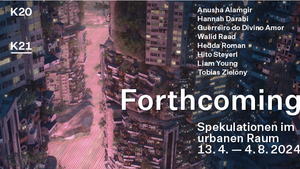glas körper // Sophie Esslinger
In the organizer's words:
Moving into a solid state, transition, temperature - the world in flux. The mental space becomes a pictorial world in the form of a frieze. The illustrated book does not present a linear narrative, but instead forms an associative chain that illuminates the field of tension between the inner and outer worlds. Central to this is the allegorical content of form and figure, the confrontation with perception. The seen and the remembered are juxtaposed with the fictional.
The relationship between form and atmosphere, the forms themselves and their dissolution is essential. Contradictions and interstices are consciously formulated: hard and soft, sharp and round, body and amorphous state, day and night, the recognizable and the irrational.
Sophie Esslinger
Sophie Esslinger's works reveal a preoccupation with transgressions of perception as well as a design that attempts to put a stop to this dynamic and is conditioned by the formal principles of drawing. Her works reflect her enthusiasm for painting, graphics and drawing; the main painting media are ink, oil and acrylic. In her pictures, the painter takes up intellectual motifs associated with Romanticism and their continuation in Symbolism and Surrealism. This recognition of the other of reason explores threshold moments between the real and the unreal, turns to inner worlds of emotion, the dreamlike and the hallucinatory and in this way tests the possibilities of being able to be different. For these possibilities, Sophie Esslinger finds a processual expression of dissolving boundaries and dissolving forms, finding and avoiding identity. This inner dynamic also becomes virulent in the transformation potential of pictorial means - artist and viewer are united here in a processual event that continues in a re-encounter with changing motifs, as is particularly striking in the small-format, sequenced pictures. The shapes of flowers, suns or eyes reveal landscapes as well as bodies, and sometimes the viewer's gaze is guided by arrows pointing out visual axes. Lines, color and scale, but also compositional elements and details literally come to the viewer's attention. Esslinger reflects what is seen, felt and thought as something depicted. Oval objects, spherical and circular shapes are formed into drops and tears and are continued in a series of eye motifs.
Julia Martel













